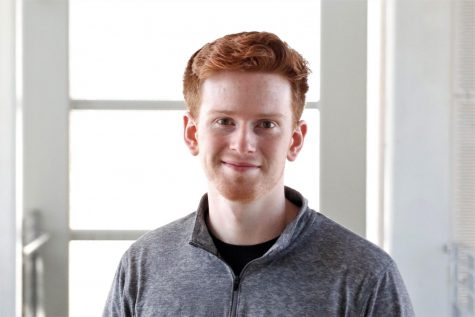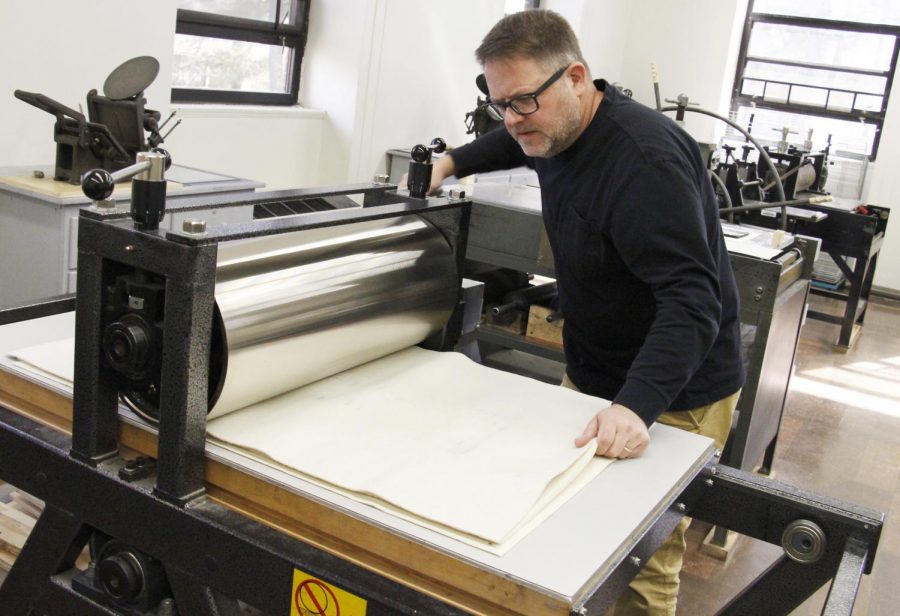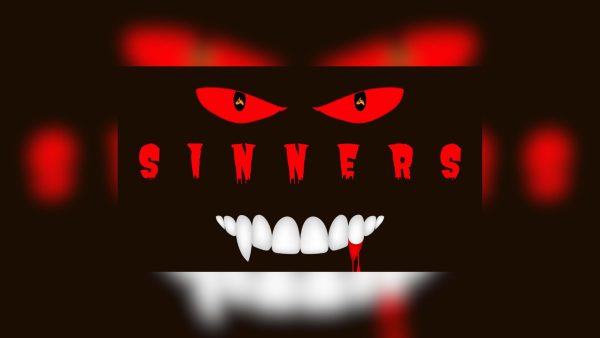A professor’s passion and pursuit for printmaking
Jacob Summerville/The Lion’s Roar
Ernest Milsted uses one of the printmaking machines located in Clark Hall room 303. His passion for photography, printmaking and the creativity of his students serves as an inspiration for his art.
From film to photography to printmaking, Ernest Milsted has found a career as an associate professor of printmaking at the university to be a great fit for his interests and skills.
A native of Houma, Louisiana, Milsted attended Nicholls State University for his undergraduate career. He was indecisive about what degree program to pursue but was ready to transfer to the University of New Orleans when he discovered his interest in film.
Before heading to UNO, his professor for a black and white film course, Dennis Sipiorski, currently, a professor of ceramics at Southeastern Louisiana University, took an interest in Milsted’s work.
“This was the first time that a college professor had taken interest in me, and so I stayed at Nicholls, and I changed my major to art, and I took every photography class that I could take with Dennis,” said Milsted. “After I got to the end of that, I took a screen printing class, and I found that I could use my photographs in conjunction with screen printing to sort of make a new image.”
Milsted completed his undergraduate career at Nicholls in 2002, earning a Bachelor of Arts with a concentration in photography and printmaking. He then attended Notre Dame to pursue his master’s degree.
After graduating from the University of Notre Dame in 2006, Milsted went back home for the summer and decided to drop by Southeastern’s Visual Arts department.
“I knew that Dennis had come here to become the department head here at the time,” shared Milsted. “So, I said, ‘One day, I’m just going to pop in and visit Dennis,’ and so I did, and he said, ‘Hey, we need a printmaker here. Didn’t you just graduate?’”
In the fall of 2006, Milsted took a position at the university as an instructor of printmaking and drawing. Then in 2013, he accepted a position as an associate professor of printmaking.
During his time at the university, Milsted has researched the coastal erosion in Louisiana, using his photographs as a framework for printmaking.
“I take these trips to coastal Louisiana every summer and spring and photograph that place in the hopes of sort of recording what’s going on there and also to reconnect with that place that I call home,” explained Milsted. “I will use an old-school 35 mm film camera to take photographs down there. Somehow, that old-school technology sort of serves that type of imagery better.”
Along with other pictures and maps, Milsted uses these pictures to create a printed image.
Milsted shared that he loves the career he sought and found.
“I’m not going to get rich doing this, but I make a pretty good living, and I love what I do, and I think that’s really important for any person in college that is looking for a career,” said Milsted. “To love what you do is really important. It’s more important than the money part of it.”
James Gilette, a student of Milsted’s, explained what he enjoys about Milsted’s instruction.
“I really appreciate the time he takes to really teach you how to do whatever the material is, from concept to execution,” said Gillette. “He definitely knows how to keep you busy for the entire class, which really helps a 2 hour and 45-minute studio fly by.”
Milsted explained how his career has allowed him an opportunity to work with creative minds.
“I get to work on projects that I wouldn’t have thought of before because students bring that into class,” said Milsted. “Together, we can kind of solve problems and creatively come up with a solution so they can express themselves.”
Your donation will support The Lion's Roar student journalists at Southeastern Louisiana University.
In addition, your contribution will allow us to cover our annual website hosting costs.
No gift is too small.

Jacob Summerville, a history and political science major, has worked at The Lion's Roar since September 2017. A native of Greenwell Springs, LA, Jacob...






Michael • Aug 10, 2024 at 7:09 am
Too bad Ernest, and Dennis at that, are both bigots. Also, reasons number 1 and 2 that I didn’t get my undergrad degree… After I had already been tentatively accepted into an MFA program… Because I was making autobiographical work about being a gay man in the south. They both said my work was “not family friendly enough to be in the senior show.” Well, is it college, elementary school, or Sunday school? Cuz… I thought it was college…